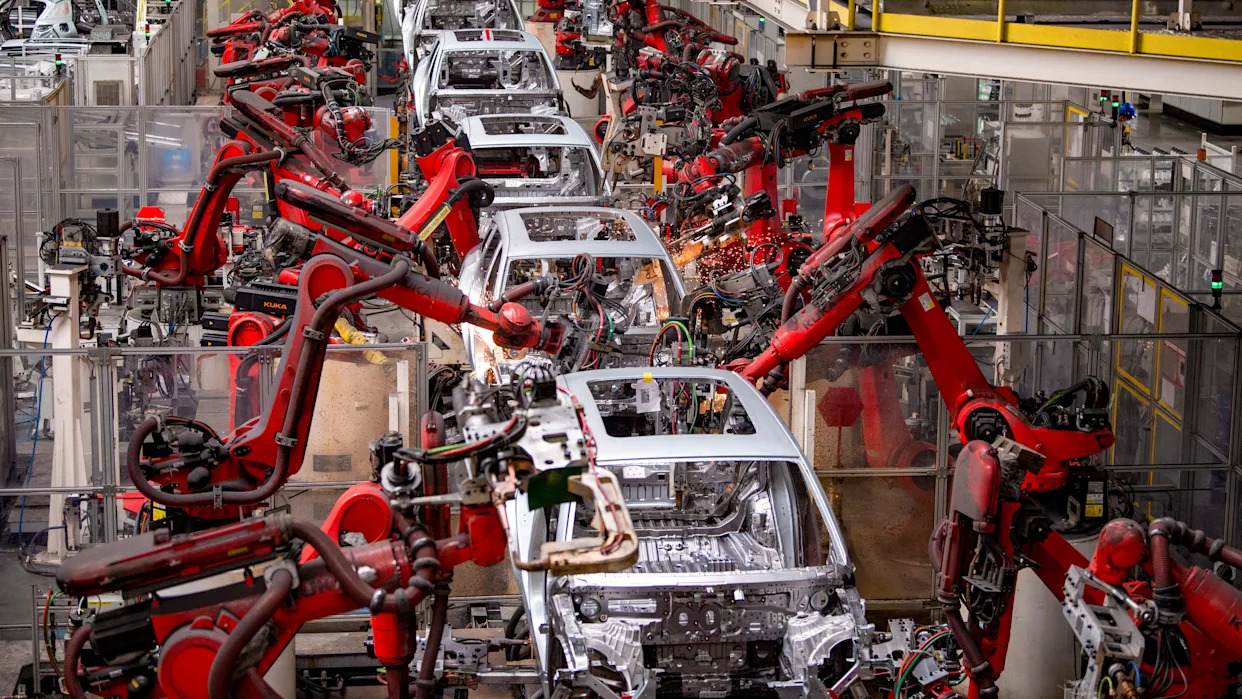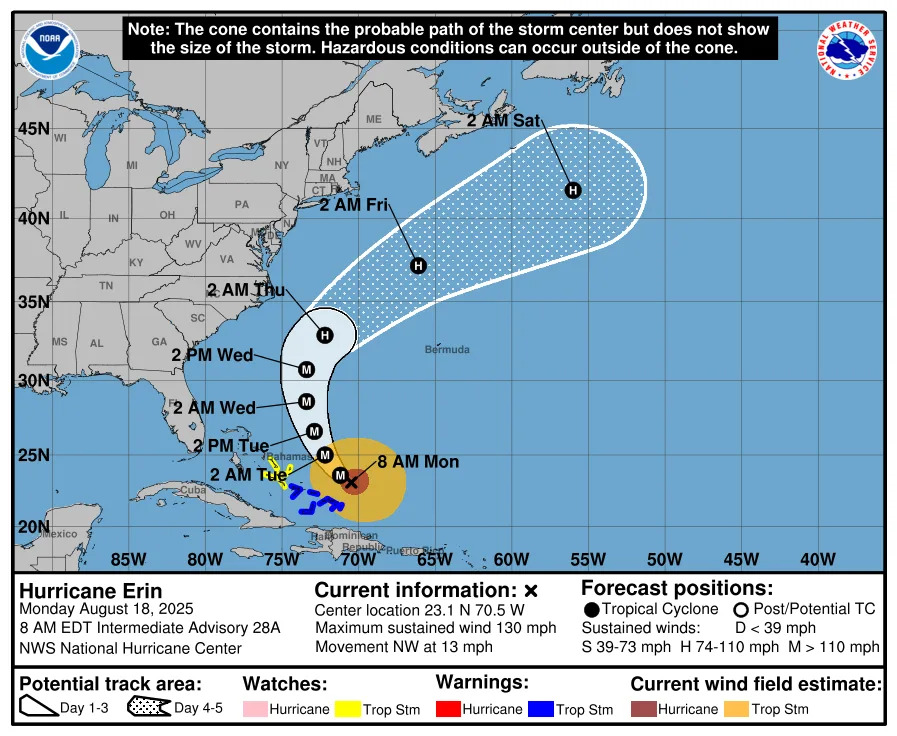
The Atlantic Daily, a newsletter that guides you through the biggest stories of the day, helps you discover new ideas, and recommends the best in culture. Sign up for it here.
After Donald Trump announced ruinously high tariffs on China in the spring, a simple reminder of that country’s growing technological power forced him to back down. Shortly after Trump’s April 2 tariff announcement, Beijing abruptly suspended exports of rare-earth magnets.
Automakers around the world panicked. These magnets—manufactured in Chinese factories from crucial metals extracted mostly from Chinese mines—have become essential for building cars. Ford Motor paused production at a plant in Chicago. Automotive-lobbying organizations in the United States and Europe warned that car companies were weeks away from halting production. A few reportedly were considering moving some production to China in order to maintain access to supplies. On May 12, the White House agreed to lower tariff rates for China before it had announced trade deals with Europe, Canada, Japan, or other allied countries.
China produces 90 percent of the global supply of rare-earth magnets, which are not the only products that Beijing can deny the rest of the world. Decades of industrial policy and fierce entrepreneurialism have created the world’s mightiest manufacturing machine. Chinese firms are also dominant producers of many pharmaceutical ingredients (especially for antibiotics and ibuprofen), battery materials, and entire categories of electronics components—not to mention smartphones, household appliances, toys, and other finished goods that American consumers want.
In cutting off rare-earth magnets, officials in Beijing flexed but one finger. If they wanted, they could have strangled vital sectors of the American economy.
How did America lose so much productive capacity to China and end up in such a vulnerable position? Think about it this way: China is an engineering state, which treats construction projects and technological primacy as the solution to all of its problems, whereas the United States is a lawyerly society, obsessed with protecting wealth by making rules rather than producing material goods. Successive American administrations have attempted to counter Beijing through legalism—levying tariffs and designing an ever more exquisite sanctions regime—while the engineering state has created the future by physically building better cars, better-functioning cities, and bigger power plants.
Engineers have quite literally ruled modern China. As a corrective to the ideological mayhem of the Mao years, Deng Xiaoping promoted engineers to the top ranks of China’s government from the 1980s onward. By 2002, all nine members of the politburo’s standing committee—the apex of the Communist Party—had trained as engineers. Xi Jinping studied chemical engineering at Tsinghua University, China’s most prominent science institution. At the start of his third term, in 2022, Xi filled the politburo with executives who had experience in aerospace and weapons.
Huge bursts of construction define today’s China. A person born in 1993—when the country built its first modern expressway—was able, when she reached the legal driving age 18 years later, to motor across a network of highways that surpassed the length of America’s interstate system. As part of China’s economic transformation, officials in Beijing have directed the construction of high bridges, large dams, enormous power plants, and entire new cities. The corporate sector, abetted by government policies that encourage manufacturing, is fixated on production too. A rough rule of thumb is that China produces a third of the world’s manufacturing, including essential products such as structural steel and container ships.
[Derek Thompson: The disturbing rise of MAGA Maoism]
The United States, by contrast, has a government of the lawyers, by the lawyers, and for the lawyers. More than half of U.S. presidents practiced law at some point in their career. About half of current U.S. senators have a law degree. Only two American presidents worked as engineers: Herbert Hoover, who built a fortune in mining, and Jimmy Carter, who served as an engineering officer on a Navy submarine. (Hoover and Carter are remembered for many things, especially for their dismal political instincts that produced thumping electoral defeats.)
Lawyerly instincts suffused Joe Biden’s economic policy, which brushed aside the invisible hand in favor of performing surgery on the economy—a subsidy scheme for one corporation, an antitrust case against another. Biden hoped to reindustrialize America via landmark bills such as the Bipartisan Infrastructure Law and the Inflation Reduction Act, but his administration’s legalistic commitments repeatedly tripped up the pace of construction. Executive agencies were so obsessed with designing rules for how to do things that little ended up being built. Efforts to connect rural areas to broadband or create a network of electric-vehicle-charging stations barely broke ground before voters reelected Donald Trump.
Trump is not a lawyer, but he—like many wealthy Americans—is no stranger to using the courtroom to get what he wants. His business career and his presidency have been rife with lawsuits: against business partners, political opponents, news outlets, and sometimes his own lawyers. Trump’s governing style has a litigious air to it too: flinging accusations left and right, intimidating people into dropping their opposition, besmirching people in the court of public opinion. Where Biden was plodding and proceduralist, Trump is naturally inclined toward bare-knuckle lawfare.
The lawyerly society has some important advantages. You can’t build companies worth trillions without the rule of law to set up an environment where the rich feel safe to invest. The U.S. remains home to most of the world’s most valuable companies, in part because lawyers protect their right to profit off of their intellectual property. But the fact that wealthy companies and individuals can easily assert their interests in court is hardly a guarantee of broad economic progress for a society.
The United States has made the geopolitical mistake of bringing lawyers to a showdown with China on trade and technology. The first Trump administration levied an initial round of tariffs on Chinese goods and added scores of Chinese tech companies to trade blacklists. The Biden administration refined technology-export controls, designing exquisite webs to ensnare Chinese chipmakers, telecommunications firms, and any company hoping to deploy AI. Xi Jinping, meanwhile, surrounded himself with scientists and engineers.
Xi grew up in a China whose Communist Party leaders nursed grievances about imperialist incursions. They understood the Soviet Union to have become strong and modern through heavy industry. China unveiled its first Five-Year Plan in 1953, the year that Xi was born. In the fall of this year, Xi will put the finishing touches on the 15th Five-Year Plan.
[Thomas Wright: Trump wasted no time derailing his own AI plan]
In the intervening years, ceaseless construction has helped reinforce the Communist Party’s political resilience. Building so many homes, bridges, and power plants means that the material benefits for most of China’s population are widely spread. Chinese citizens have seen their conditions of life improve immeasurably over the past 40 years. The steady improvement of parks and subway networks makes urban residents expect that the future will be even better. When Chinese people point to new cities that shimmer at night with drone displays, or metropolises connected to one another by a glistening high-speed-rail network, they show genuine pride, in my experience. One way to impress 1 billion–plus people is to pour a lot of concrete.
China has also turned itself into an energy superpower. Two decades ago, it produced about half of the electricity that the United States did. Today, it generates twice as much. Beijing is simultaneously attempting to wean itself off oil imports while leading the world in an “all of the above” energy strategy that includes coal, nuclear, and wind plants, plus astounding amounts of new solar capacity. Beijing recently announced the construction of the Yarlung Tsangpo dam, which will use 60 times more cement than the Hoover Dam and will dwarf the already gigantic Three Gorges Dam. By the end of this year, more than half of the cars sold in China today will be electric—again the product of forceful policy.
The engineering state is effective at making military goods too. China produces about 80 percent of the world’s consumer drones, which can easily be adapted for the battlefield. China has approximately 200 times the shipbuilding capacity of the United States; according to the General Accounting Office, many classes of U.S. Navy ships are delayed by up to three years. Last December, then–National Security Adviser Jake Sullivan said bluntly that the United States will experience “exhaustion of munition stockpiles very rapidly” if it were ever to face the Chinese military. America has lost the productive capacity to sustain a major war. American manufacturing output has never recovered to its highs from 2008; the manufacturing workforce has shrunk by a million people since then.
The United States has lost the ability to get stuff done as it focuses on procedures rather than results. In 2008, residents of California—the crucible of the American modern economy—voted to fund a high-speed-rail link between San Francisco and Los Angeles. That same year, China began construction of its high-speed-rail line between Beijing and Shanghai. China’s line opened in 2011 at a cost of $33 billion. In its first decade of operation, it completed more than 1.3 billion passenger trips.
Seventeen years after the ballot proposition, California has built a small stretch of rail to connect two cities in the Central Valley, neither of which is close to San Francisco or L.A. The latest estimate for California’s rail line is $135 billion. The first segment of California’s train will start operating, according to official estimates, between 2030 and 2033. That’s a margin of error of three years—the same length of time that China needed to build the entire Beijing–Shanghai line.
Even far smaller projects—a public bathroom, a bus-stop sun shelter—turn out underwhelming, embarrassingly late, or over budget. Americans today live in the ruins of an industrial civilization where the remaining infrastructure is barely maintained and rarely expanded. The result is a deep sense that nothing is working.
The United States wasn’t always like this. It once had the musculature of an engineering state, where lengthy train tracks, gorgeous bridges, beautiful cities, weapons of war with terrible power, and rockets to the moon were built. When the United States had surging population and economic growth through the 19th century, political elites agreed that its wide territories needed canals, rails, and highways. America’s construction boom slowed down after the 1960s.
[Patrick George: The American car industry can’t go on like this]
What happened then? The American public revolted against environmental harms, the highways then being rammed through urban neighborhoods, and industry regulators who were cozy with big companies. The legal profession started to change. Before the ’60s, prominent lawyers filed into government to enact programs such as FDR’s New Deal. Afterward, idealistic law students followed in the footsteps of the young Ralph Nader, who campaigned to be a watchdog of alleged government abuses. “Sue the bastards,” a slogan of that era declared, urging environmentalists and other activists to take government agencies to court.
A righteous impulse from that era has convinced many Americans that physical dynamism is undesirable and has robbed society of its ability to improve itself. Rather than expanding new subway systems, building nuclear-energy plants or rare-earths-processing facilities, or designing the path for a new transmission line, many of the country’s smartest engineers have been seduced by Wall Street and Silicon Valley, where they can have more fun and make a lot more money.
I am not suggesting that the United States copy China’s approach. The engineering state’s spectacular successes have come at staggering costs. Beijing treats its citizens as yet another building material and Chinese society as something to be engineered too. Officials have restricted ethno-religious minorities in Tibet and Xinjiang from practicing their religion and perpetuating their cultures. Only the engineering state could have pursued the one-child policy, which was ultimately a campaign of rural terror enforced through mass sterilizations and forced abortions. China’s efforts to engineer the economy—which have produced slumping real-estate values and a collapse in corporate valuations—have frightened entrepreneurs and their investors. Beijing’s efforts to engineer society have made many young people feel adrift, with a substantial portion desiring to emigrate abroad.
In spite of sluggish construction, lawyers are a guarantor of America’s great advantage against China: pluralism, or the ability of diverse cultures to coexist and thrive under equal protection. Americans are engaged in robust debate about how to make their country better. The United States is more dynamic than Europe and can look to its own history to see the path forward. You can see the remnants of the engineering state amid the mighty industrial works scattered all over the country. Americans can draw on that legacy to stage their country’s next act of transformation.
I like to imagine how much better the world would be if both superpowers could adopt the pathologies of the other. China would be better if it could be more lawyerly, which means embracing substantive legal protections for individuals. America needs an engineering culture to build homes, build mass transit, and build the energy systems necessary to decarbonize. Ultimately, if America refuses to build, it will be subject to the whims of countries that do.
Dan Wang is a research fellow at Stanford’s Hoover Institution. This essay is adapted from Breakneck: China’s Quest to Engineer the Future.








Comments